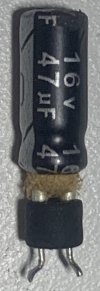
Waited for a response on advice from this group to help fix this amp. Received near nothing since posting last December 10, 2023. Embarked on my first dive into fixing this interesting powerful amplifier.
Began with visual inspection which I can say was lacking as did not spot this blown cap supporting input on ch7 until several days later while re-acquainting self with new scope have not touched in months.
Both ch7 and ch8 are dead at output, but, ch8 is alive and well all the way to an 8 pin relay at output which apparently---simultaneously switches both ch7 and ch8 if logical conditions following voltages I can imagine are not met per circuit immediately adjacent to this relay.
If correct logic is met, audio output is switched on for both ch7 and ch8. Understandably, is switched off if not as can result in damaged speakers and other potential roasting while loaded.
Confirmed ch7 is toast so no matter what with ch8, it is also down as logic addresses either channel and switches both off at relay if one is not in specification.
The metal case on capacitor had nearly popped completing off for ch7, can't be helping leaving it that way....see if you can spot the blown capacitor at input for ch7, stands taller, since is popped, than all others which are level with each other.
A few notes:
1.) As noted not the case by author stating unmarked transistors, I found transistors are marked where each channel has a PNP/NPN pair per channel with a pre-amp pair and power amp pair at big heat sink.
The voltages at the pre-amp for ch7 are 6 and 14 volts (collector, emitter) and near 53 volts at base. The collector and emitter voltages are way out of range compared to that of all other functioning channels.
2.) All the the onboard input connectors for each channel appear to be glued into place! Attempted to disconnect, did not wish to force, leaving connected for now.
Ordering a replacement capacitor tonight, any advice on troubleshooting appreciated.

